Roma: La Città Eterna
Reflections Upon Four Months in Rome
I awoke, my palms sweaty and my blood turned cold, my perception of that instantaneous moment stretched out over an infinite expanse of time, as if I were on my deathbed experiencing what I realized to be my final moments of consciousness. “What will I have to do?” my panicked ego finally manages to demand of my superego. This was some unknown distance far over the Atlantic Ocean in the middle of an overnight flight to get from Chicago to Rome, Italy. The furthest I’ve been outside of the United States during my twenty-one years on this planet has been to go from Michigan to Ontario, and here I was on an airplane, about to start a five-and-a-half month long study and travel period in Europe. I spoke absolutely no useful Italian and (perhaps wisely, perhaps carelessly) only packed a backpack and duffel bag to sustain me that entire time. The prospect of how many trials and tribulations I’d surely go through before I’d see my familiar home again finally hit me after a calm, cool and collected departure.
The panic was only momentary, and before long I was stepping off the plane into Rome Fiumicino Airport, sparkling eyes filled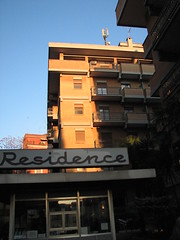 with wonder at my first sights of Europe… which had as much English in an airport that looked more drably American than in the international departure portal which was Chicago O’Hare. Once we got into the city things began looking more ‘Italian’, and I sort of wondered when the culture shock that the Office of Study Abroad spent so much effort warning us about would hit me.
with wonder at my first sights of Europe… which had as much English in an airport that looked more drably American than in the international departure portal which was Chicago O’Hare. Once we got into the city things began looking more ‘Italian’, and I sort of wondered when the culture shock that the Office of Study Abroad spent so much effort warning us about would hit me.
Cultural Note #1: In Europe, the ‘floors’ of a building start at zero for ground, with the floor above it being first floor. This would have been useful to know when I first arrived at my apartment, where I was told my room was on the fifth floor, which was really the American sixth floor, and not after walking back down to the fourth floor to see if I missed it, all while hauling my luggage with me after some twenty hours of air travel and transfers.
I’m not sure if they expected these little cultural differences to shock me or if there was something else about being on a different continent, but during my first couple days of general orientation and jet-lag recovery, I found the greater shock came from trying to live in an apartment with six other American students, many of whom came together from Notre Dame and spent a good deal of time scheming how to make our apartment the party capital of the entire apartment complex. I don’t do parties and drinking and loud pop music very well. But for that matter I don’t do socialization very well. The very existence of this website should indicate some things about the amount of time I devote alone working on my laptop rather than out doing more typical college student things. Indeed, I could barely get through the first night before being singled out as the outcast of the group.
“Jeremy, why don’t you play a couple rounds of beer pong with us?”
“I’m fine just watching, thanks.”
“What are you spending so much time on the computer for?”
“Well, recently I’ve been working on an essay that contemplates the self-contradictory attitudes and epistemological uncertainty I have towards this wooden roller coaster in Indiana…”
“You should spend more of that time out here with everyone else. The point is to have fun and be yourself!”
I always hate it when someone tells me to ‘be myself’, especially as it’s nearly always coupled with a request for a display of more flamboyant outgoingness. Does it never occur to them that I am being myself right now, and if I were to suddenly ‘break out’ and join the party I would only be putting on an elaborate charade in order to convince others my personality isn’t naturally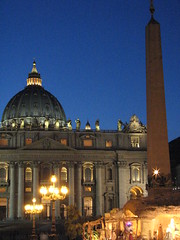 one of quiet reserve and hesitancy in social situations. But maybe they’re right, it’s good practice for a world in which it’s not what you know but who you know, and when contacts are a currency I seem to be a rather poor individual.
one of quiet reserve and hesitancy in social situations. But maybe they’re right, it’s good practice for a world in which it’s not what you know but who you know, and when contacts are a currency I seem to be a rather poor individual.
Cultural Note #2: You have to buy your grocery bags when you go shopping. They cost about 5 eurocents each, or you can bring your own bags.
The walk from our apartment to the campus literally requires we cross through St. Peter’s Square. After a couple days of orientation and then returning to the apartment I was beginning to get a feel of what life in Rome was like, but still hadn’t gotten out to explore the city. The Sunday before classes began the school hosted a free walking tour of Ancient Rome which I got up early enough in the morning to go to. The day unfortunately was a very grey, overcast, occasionally rainy Italian winter day, and did no justice to the vibrancy of colors that would reveal themselves later in the spring. We started by crossing the Tiber River, walked through the Jewish Ghetto (home to the oldest Synagogue in Europe; the Pope was due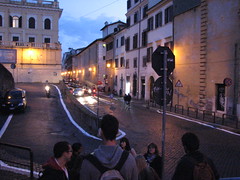 to hold a meeting there later that day), crossed over by the Teatro di Marcello, the Temple of Juno and Jupiter, up Capitoline Hill and then held a break on top of the Vittorio Emmanuelle II Monument. Afterward we crossed down through the Roman Forum, via the road Mussolini had laid down through the middle of it so he could get a clear view of the Coliseum from his palace. After the tour ended I went with Sasha, Chelsea and Jason (Sasha and I would share two philosophy classes that semester) and took a lengthy walk to see Circus Maximus (once the site of the chariot races; today just a long, open field that’s probably used for special events), the Pantheon, and had lunch at the Trevi Fountain before wandering back to Trastevere to get gelato… in total about eight hours of walking.
to hold a meeting there later that day), crossed over by the Teatro di Marcello, the Temple of Juno and Jupiter, up Capitoline Hill and then held a break on top of the Vittorio Emmanuelle II Monument. Afterward we crossed down through the Roman Forum, via the road Mussolini had laid down through the middle of it so he could get a clear view of the Coliseum from his palace. After the tour ended I went with Sasha, Chelsea and Jason (Sasha and I would share two philosophy classes that semester) and took a lengthy walk to see Circus Maximus (once the site of the chariot races; today just a long, open field that’s probably used for special events), the Pantheon, and had lunch at the Trevi Fountain before wandering back to Trastevere to get gelato… in total about eight hours of walking.
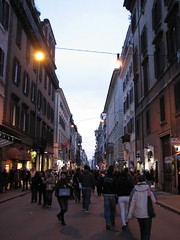 Cultural Note #3: In Italy you don’t tip in restaurants, a 15% gratuity is included in the price of the food. Waiting is an actual profession that pays very well and most people that become waiters are waiters for life.
Cultural Note #3: In Italy you don’t tip in restaurants, a 15% gratuity is included in the price of the food. Waiting is an actual profession that pays very well and most people that become waiters are waiters for life.
Supposedly the first stage of culture shock is excitement, and this is followed by withdrawal. That never happened. Instantly I felt more at home as an anonymous face in a foreign environment than I did at home where I must always worry what cryptic norms would be expected of me. “Sono Americano, non parlo Italiano” was all I’d have to say, and I had successfully disappeared. Life became a movie, and there was no existential fear attached to my status as an actor in it. I was now the silent observer, disembodied from the extended world, intimately close with the people and environment but outside it as an invisible spectator. I was free.
Freedom has a price. While there are few greater satisfactions the postmodern world can provide an individual than the opportunity to completely disappear, sooner or later that individual is going to need to resurface, and when they do there are few feelings more horrible than having no souvenirs to show from their disappearance (that perhaps partly explains the existence of this website). Therefore I decided it was time to make an effort to get to know roommates and other students, trying to at least show my presence at gatherings, going with roommates on errands or explorations of the city, and trying to find people to talk to (or at least walk with) on the daily stroll to and from my apartment from school.
Cultural Note #4: Parking in Rome is limited only by the creativity of the driver. Double-parking, alleys, sidewalks, grass, highway medians… it’s all fair game.
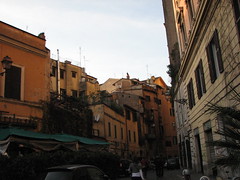 My classes were located in an area of Rome known as Trastevere, which is located along the western banks of the Tiber River (most Roman landmarks are east of the Tiber) and is what one generally thinks of when they picture the small, winding cobbled streets of Italy, strings of lights or clotheslines stretched overhead and the vine-covered terraces of small cafes and ristorantes. While it was hard to organize my apartment into a group for dinner out (mostly we cooked our own food; my specialties were frozen pizzas, noodles with plain pomodoro sauce, and Nutella and jelly sandwiches, which I am still recovering from) the few times we did go out it would be to a place called Toni’s, which offered reasonably cheap food in a funky small hole in the wall. I was surprised by how ‘basic’ all of the food off the menu was.
My classes were located in an area of Rome known as Trastevere, which is located along the western banks of the Tiber River (most Roman landmarks are east of the Tiber) and is what one generally thinks of when they picture the small, winding cobbled streets of Italy, strings of lights or clotheslines stretched overhead and the vine-covered terraces of small cafes and ristorantes. While it was hard to organize my apartment into a group for dinner out (mostly we cooked our own food; my specialties were frozen pizzas, noodles with plain pomodoro sauce, and Nutella and jelly sandwiches, which I am still recovering from) the few times we did go out it would be to a place called Toni’s, which offered reasonably cheap food in a funky small hole in the wall. I was surprised by how ‘basic’ all of the food off the menu was. When I think of American styled Italian food, even at the cheapest commercial food outlets, there’s this myth that it’s somehow really ‘fancied up’ with lots of spices, seasonings, or added food textures which make it not always entirely obvious what it was you’re eating. At least in my experience, if I ordered pasta with marinara, that was exactly what I got. It might be really good pasta with marinara, but nevertheless it would sort of be lacking presentation. I learned I had to be more adventurous with my meals, and on our last night out I got a strange noodle confection cooked in a fried grated cheese basket that was quite unlike anything I had seen or expected (but it was good).
When I think of American styled Italian food, even at the cheapest commercial food outlets, there’s this myth that it’s somehow really ‘fancied up’ with lots of spices, seasonings, or added food textures which make it not always entirely obvious what it was you’re eating. At least in my experience, if I ordered pasta with marinara, that was exactly what I got. It might be really good pasta with marinara, but nevertheless it would sort of be lacking presentation. I learned I had to be more adventurous with my meals, and on our last night out I got a strange noodle confection cooked in a fried grated cheese basket that was quite unlike anything I had seen or expected (but it was good).
When between classes I’d generally get a slice of pizza at a place called La Renella, which served a distinctive style thick crust pizza, which would be about normal thickness for American style pizza. Despite the crust it was far from Americanized, quite the contrary. Most of what I’d order would be with garlic sauce rather than tomato, and the toppings were generally things like layers of ham or prosciutto, or a mix of cheeses or vegetables (the cheese was always worth it as they would often use large globs of feta or layers of the richest, densest cheese I’ve ever seen attempted on a pizza). La Boccaccia was another pizza shop near the school which sold more traditional thin crust style pizza cut in squares with various toppings (never pepperoni, which in Italian would translate to bell peppers… still a very good choice of topping, I might add). Many of the locals eat their pizza by folding two halves together sandwich style, which I tried and rejected. Not to criticize the ‘traditional’ way of pizza consumption, but you want to eat it open-faced where the flavors will aromatically explode in one’s mouth rather than remained constricted between the two pieces of crust.
globs of feta or layers of the richest, densest cheese I’ve ever seen attempted on a pizza). La Boccaccia was another pizza shop near the school which sold more traditional thin crust style pizza cut in squares with various toppings (never pepperoni, which in Italian would translate to bell peppers… still a very good choice of topping, I might add). Many of the locals eat their pizza by folding two halves together sandwich style, which I tried and rejected. Not to criticize the ‘traditional’ way of pizza consumption, but you want to eat it open-faced where the flavors will aromatically explode in one’s mouth rather than remained constricted between the two pieces of crust.
Cultural Note #5: In Italy dinner is held between 8:00 and 11:00pm.
The following slideshow depicts my apartment in the Residence Medaglie d’Oro and my daily walk to school, which technically crosses through another country. While it was a bit far of a distance (45-50 minutes by foot, 25 minutes to an hour and a half by bus… that’s Roman public transportation for you) it always made for a pleasant way to start or end the school day.
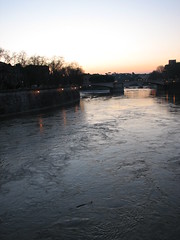 One day Rome experienced snow. I really couldn’t be bothered to notice or care about this. I saw some snow on the side of the street on my walk into school, and later discovered that I had witnessed the first snow in Rome in over twenty-six years. Who knew? My focus was more on class work, which I unfortunately can’t claim was particularly challenging except for some of the wrong reasons. The school is run slightly more like a high school than a college, and was clearly marketed for students looking to have a fun semester in Europe more than anything else… where are all the serious places an American student can go in Rome, I wondered occasionally. My best professor was by far in Modern Philosophy, but as he was actually fully qualified to teach that class the college refused to pay him what he would be owed, so he didn’t so much hold a ‘class’ as hold an hour long conversation with us on the general subject matter, which would more or less start or end however he chose on whichever days he felt like coming in. Regardless, Sasha and I agreed he was much better than in Philosophy of Art and Beauty, which consisted of looking at renaissance and abstract paints, having some oblique lecture about why we judge each differently, and then (mercifully)
One day Rome experienced snow. I really couldn’t be bothered to notice or care about this. I saw some snow on the side of the street on my walk into school, and later discovered that I had witnessed the first snow in Rome in over twenty-six years. Who knew? My focus was more on class work, which I unfortunately can’t claim was particularly challenging except for some of the wrong reasons. The school is run slightly more like a high school than a college, and was clearly marketed for students looking to have a fun semester in Europe more than anything else… where are all the serious places an American student can go in Rome, I wondered occasionally. My best professor was by far in Modern Philosophy, but as he was actually fully qualified to teach that class the college refused to pay him what he would be owed, so he didn’t so much hold a ‘class’ as hold an hour long conversation with us on the general subject matter, which would more or less start or end however he chose on whichever days he felt like coming in. Regardless, Sasha and I agreed he was much better than in Philosophy of Art and Beauty, which consisted of looking at renaissance and abstract paints, having some oblique lecture about why we judge each differently, and then (mercifully)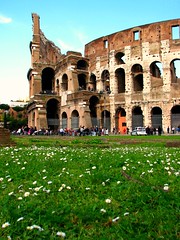 giving me an A+ on everything I turned in having spent zero effort on because I was in the minority of students that actually knew anything about real philosophy. My final essay consisted mostly of material I had earned in other classes, which I again got an easy A with no criticisms whatsoever. If the class was going to be all speculative dialogues about classical and modern art with little to do with how aesthetic theory is actually applied in philosophical works (it’s not just about being able to say why a painting is pretty, but has been used as foundations for entire moral, political and metaphysical doctrines) we could have at least included one or two fieldtrips to art galleries in Rome.
giving me an A+ on everything I turned in having spent zero effort on because I was in the minority of students that actually knew anything about real philosophy. My final essay consisted mostly of material I had earned in other classes, which I again got an easy A with no criticisms whatsoever. If the class was going to be all speculative dialogues about classical and modern art with little to do with how aesthetic theory is actually applied in philosophical works (it’s not just about being able to say why a painting is pretty, but has been used as foundations for entire moral, political and metaphysical doctrines) we could have at least included one or two fieldtrips to art galleries in Rome.
Cultural Note #6: Bottled water is ordered either “con gas” or “senza gas”. Con gas will get you a fizzling, soda-like water beverage that every American I’ve talked to so far agrees just doesn’t taste right.
I felt like I hadn’t been seeing enough of Rome and needed to find some more sights of interest. I had seen some photos of a bizarre-looking Square Coliseum built in an area of Rome envisioned by Benito Mussolini called the EUR (Esposizione Universale Roma). The Square Coliseum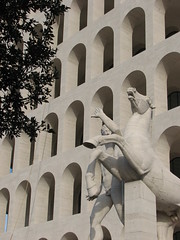 (aka the Palazzo della Civiltà Italiana) was built between 1938 and 1943, and it current stands silent as it’s been undergoing renovations since 2003. Between the pristine, modernist shine of the marble against the cobalt blue sky, and the desolate, vacant surroundings recalling a bygone era in which fascism represented the future, there was a mildly surreal atmosphere. Perhaps more strange was that the rest of the EUR, conceived by Mussolini as the absolutist architectural ideal once they conquered the world and rid it of undesirable thinking, wasn’t completed before the war broke out, but afterward the Italians felt a sense of duty to finish the construction anyway.
(aka the Palazzo della Civiltà Italiana) was built between 1938 and 1943, and it current stands silent as it’s been undergoing renovations since 2003. Between the pristine, modernist shine of the marble against the cobalt blue sky, and the desolate, vacant surroundings recalling a bygone era in which fascism represented the future, there was a mildly surreal atmosphere. Perhaps more strange was that the rest of the EUR, conceived by Mussolini as the absolutist architectural ideal once they conquered the world and rid it of undesirable thinking, wasn’t completed before the war broke out, but afterward the Italians felt a sense of duty to finish the construction anyway.
Before the EUR I made a stop on the Metro to check out the Piramide Cestia (Pyramid of Cestius) along the Aurelian Wall, and then on my way back to the apartment I got off at Villa Borghese. A fantastic way to spend a spring evening in Rome, I nearly forgot that the insane traffic even existed in the middle of this sprawling park ground located in the middle of the city.
Cultural Note #7: Speaking of fascism, Italy has a set of anti-terrorism laws in place which positively forbids anyone living in a rented housing (which I assume are the majority of people living in Rome) from having overnight guests between the hours of 11:00pm and 6:00am. And I thought the USA PATRIOT Act was politically controversial… This of course led to unique problem-solving by my roommates whenever they had a friend visiting that needed a place to stay or were looking to get lucky that night.
I wish I had the opportunity to meet more Italians while in Rome. There were a few occasions, most notably when I went to visit our extended family in Venice, but otherwise I mostly got to know more American students. The few occasions when I did get into an actual conversation with someone from Rome, I would inevitably direct it towards my love for Italian cinema. Part of this was a sense of duty to dispel any potential stereotypes that Americans only watch their own movies, as one could reasonably expect given the prevalence of Hollywood exports to Europe, normally outweighing the number of domestic films by a fair margin. Surely if it’s hard to watch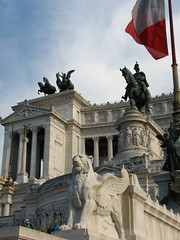 Italian films in Italy, it must be that Americans have never even seen a film not in their own language (sadly I suspect that to be true for the vast majority of the population). But also because it was nice to finally be able to discuss some of my favorite auteurs with someone else that was actually familiar with (at least some of) their names.
Italian films in Italy, it must be that Americans have never even seen a film not in their own language (sadly I suspect that to be true for the vast majority of the population). But also because it was nice to finally be able to discuss some of my favorite auteurs with someone else that was actually familiar with (at least some of) their names.
Federico Fellini most people have at least heard of, but I’m partial to his contemporary, Michelangelo Antonioni, whose L’Avventura remains one of my all-time favorite films. While everyone knows of The Good, The Bad and the Ugly, only a percentage of Americans are aware that it’s actually an Italian production using many advanced stylistic techniques that more conservative American western directors were reluctant to try. No one’s heard of Pier Paolo Pasolini, yet I was surprised to find that his name was almost more recognized and revered in Italy than Antonioni (the man was also a homosexual communist atheist, not exactly the most congenial personality for a Catholic nation). Vittorio Di Sica’s Umberto D. was perhaps one of only three movies in the past five years to make me shed a tear. So much of what we see in the movies today has its roots in Italian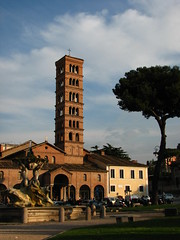 cinema, especially the direct influence it had on American directors in the 1970’s and onwards. Unfortunately the only movie I got to see in theaters during my time in Rome was Shutter Island, which seemed appropriate given Martin Scorsese’s obvious multiple Italian influences. It was difficult finding a theater that would show subtitles rather than dub it into Italian, as for some reason Italians have perhaps less patience for subtitles than Americans.
cinema, especially the direct influence it had on American directors in the 1970’s and onwards. Unfortunately the only movie I got to see in theaters during my time in Rome was Shutter Island, which seemed appropriate given Martin Scorsese’s obvious multiple Italian influences. It was difficult finding a theater that would show subtitles rather than dub it into Italian, as for some reason Italians have perhaps less patience for subtitles than Americans.
Cultural Note #8: If you are a worker in Italy, once hired you cannot be fired unless you do something that requires you to be sent to prison. Not coincidentally, you do not want to be in a situation where you require the immediate services of a plumber.
It should not be a surprise that one of my goals while in Rome was to see the Cinecittà film studios, perhaps most notable for being the location that’s stamped on the credits of the Federico Fellini movies (but also films like Ben-Hur, or more recently Gangs of New York). At first I hoped I could make it an all-day tour or museum visit, somewhat like a day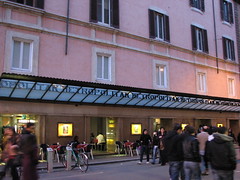 at Universal Studios or Paramount in Hollywood, although hopefully not as touristy or tacky. I got that wish at least, as I discovered that the place is essentially closed to tourists and there’s little to see but the front gates. I rode the Metro out to one of the last stops on the A line hoping that there would still be items around of interest to a fan of European cinema, but apart from the sign over the front gates and a shopping mall nearby of the same name, there was really nothing but tall walls everywhere. Supposedly they’re planning on building a large theme park similar to Universal Studios nearby (not sure how close, there were some empty fields across the road that looked promising as potential sites). Actually the barren desolation of the area did seem somewhat fitting, given that Italians themselves have been hard pressed to produce a masterpiece
at Universal Studios or Paramount in Hollywood, although hopefully not as touristy or tacky. I got that wish at least, as I discovered that the place is essentially closed to tourists and there’s little to see but the front gates. I rode the Metro out to one of the last stops on the A line hoping that there would still be items around of interest to a fan of European cinema, but apart from the sign over the front gates and a shopping mall nearby of the same name, there was really nothing but tall walls everywhere. Supposedly they’re planning on building a large theme park similar to Universal Studios nearby (not sure how close, there were some empty fields across the road that looked promising as potential sites). Actually the barren desolation of the area did seem somewhat fitting, given that Italians themselves have been hard pressed to produce a masterpiece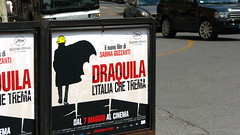 in the past thirty years while French, German, Spanish or Scandinavian cinemas continue to produce at least several noteworthy productions per year; I take it there is little doubt that Silvio Berlusconi and his monopoly on Italian media is also responsible for much of this decline. The few decent films that are made are mostly independent and political in nature (i.e. the work of Sabina Guzzanti, who is on the board of directors of our local film festival) or are much more baroque than anything the economical neorealists or modernists of prior generations would have produced.
in the past thirty years while French, German, Spanish or Scandinavian cinemas continue to produce at least several noteworthy productions per year; I take it there is little doubt that Silvio Berlusconi and his monopoly on Italian media is also responsible for much of this decline. The few decent films that are made are mostly independent and political in nature (i.e. the work of Sabina Guzzanti, who is on the board of directors of our local film festival) or are much more baroque than anything the economical neorealists or modernists of prior generations would have produced.
 The evening was not a total loss however, as just a couple blocks away from Cinecittà was Rome’s only operating ‘amusement park’, Oasi Park. Okay, it’s more of a family entertainment center squeezed into a small neighborhood block, free admission, but it also has the Mini Mouse, the only roller coaster servicing the entire Rome metropolitan area (at least until Zoomarine would open Vertigo later that year and Rainbow Magicland would open sometime in 2011). It counts, and would officially become my first European roller coaster out of an eventual 144 that season. It’s basically a re-tooled Wacky Worm layout (officially it’s a unique design exclusive to Oasi Park) with a straight drop replacing the stretch of moguls, and the second drop featuring a close headchopper with the lift. Price was somewhere in the order of €1.50. Despite its extremely small size, Oasi Park seemed to be doing very well in attendance, and the owners clearly made the most of their small plot of land, although I was mildly surprised by the numerous Disney-esque characters adorning some of the façades. A point-of-view video of the Mini Mouse is included in the slideshow below.
The evening was not a total loss however, as just a couple blocks away from Cinecittà was Rome’s only operating ‘amusement park’, Oasi Park. Okay, it’s more of a family entertainment center squeezed into a small neighborhood block, free admission, but it also has the Mini Mouse, the only roller coaster servicing the entire Rome metropolitan area (at least until Zoomarine would open Vertigo later that year and Rainbow Magicland would open sometime in 2011). It counts, and would officially become my first European roller coaster out of an eventual 144 that season. It’s basically a re-tooled Wacky Worm layout (officially it’s a unique design exclusive to Oasi Park) with a straight drop replacing the stretch of moguls, and the second drop featuring a close headchopper with the lift. Price was somewhere in the order of €1.50. Despite its extremely small size, Oasi Park seemed to be doing very well in attendance, and the owners clearly made the most of their small plot of land, although I was mildly surprised by the numerous Disney-esque characters adorning some of the façades. A point-of-view video of the Mini Mouse is included in the slideshow below.
Cultural Note #9: In Italy, the question should be “why wouldn’t someone drill into the side of a building at 7:00am each morning? For two weeks?”
Even though I only lived a fifteen minute walk from the Vatican and often walked through St. Peter’s Square twice daily, I never actually made it around to touring the inside or seeing the Pope speak on Sunday mass. Since Rome became my home it was difficult to change into tourist shoes while I was there. Why do I need to see the Vatican today when those bells are there to wake me up every Sunday morning anyway? I wasn’t against seeing the Vatican; even my Jewish roommate had it high on his priority list. The same thing with other Roman landmarks; theoretically I should have had all the time in the world to check off everything on the tourist wish list, but I left sensing there was much I had not seen that I should have. Part of the problem was that my roommates infrequently wanted to indulge in these sorts of cultural activities, and while I could have organized day tours with other people that lived closer to the school, the far distance made it hard to coordinate that sort of stuff outside of class. This meant I was left to see most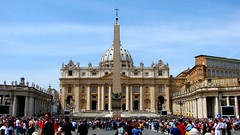 of Rome by myself, although when it came down to the last weekend we were there my roommate and I realized we needed to see the Pope, so we planned on that the last Sunday. We got there in time, where a sizable crowd had gathered, and after looking around for a while, we realized it was being telecast on big screens from another location he was visiting that week. A disappointment, especially for another one of the guys who panicked last minute in an attempt to buy a decent rosary for the Pope to bless, only to get back for us to inform him that the big screens would be doing the blessings. As luck would have it, on the very last day of exams
of Rome by myself, although when it came down to the last weekend we were there my roommate and I realized we needed to see the Pope, so we planned on that the last Sunday. We got there in time, where a sizable crowd had gathered, and after looking around for a while, we realized it was being telecast on big screens from another location he was visiting that week. A disappointment, especially for another one of the guys who panicked last minute in an attempt to buy a decent rosary for the Pope to bless, only to get back for us to inform him that the big screens would be doing the blessings. As luck would have it, on the very last day of exams 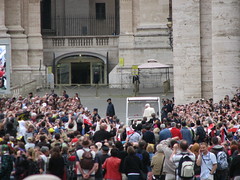 (which required we get there sooner than our normal class schedule), we found that the Pope was still in the middle of his Wednesday audience, riding around in the Popemobile. We stopped to take a photo and marveled over the good fortune that the last item on our list of things to see in Rome should randomly and unexpectedly be ticked off on our last day walking to class. I suppose not many people can claim that they have seen the Pope on their way to school.
(which required we get there sooner than our normal class schedule), we found that the Pope was still in the middle of his Wednesday audience, riding around in the Popemobile. We stopped to take a photo and marveled over the good fortune that the last item on our list of things to see in Rome should randomly and unexpectedly be ticked off on our last day walking to class. I suppose not many people can claim that they have seen the Pope on their way to school.
Cultural Note #10: Italians answer the phone “Pronto”, which literally translates to “Ready” (although more figuratively it means “go ahead” or “speak”).
On the evening of my last exam I was set to leave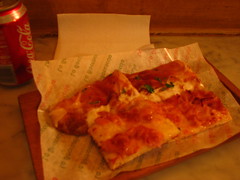 Rome for Madrid the next day. My stuff was mostly all packed and I had brought my camera with me on the intention of taking a longer route back to the apartment to get some last night shots of the city. After grabbing a slice of pizza at La Boccacchia, I set off from Trastevere walking in the general direction of the ancient landmarks, no map in pocket, just relying on my own knowledge of the city after living there for four months. The walk eventually took me out over Tiber Island, to Capitoline Hill, the Vittorio Emanuele Monument, the Roman Forum, the Coliseum, then miraculously found my way to the Trevi Fountain (which I had not visited since the first weekend in Rome), where I stopped for gelato and took in the ambiance of an entire community gathered around it in the middle of the night, then moved on to the Column of Marcus Aurelius and the Pantheon, down to Piazza del Popolo (which is practically on the other side of the ancient city), back to the Spanish Steps, back across the Tiber to the Palazzo di Giustizia and Castel Sant’Angelo, down Via della Conciliazione to the Vatican, and then back to my apartment (it was after midnight by that time). The slideshow below is basically a summary photo tour of the entirety of ancient Rome illuminated at night. (Map of the route I took)
Rome for Madrid the next day. My stuff was mostly all packed and I had brought my camera with me on the intention of taking a longer route back to the apartment to get some last night shots of the city. After grabbing a slice of pizza at La Boccacchia, I set off from Trastevere walking in the general direction of the ancient landmarks, no map in pocket, just relying on my own knowledge of the city after living there for four months. The walk eventually took me out over Tiber Island, to Capitoline Hill, the Vittorio Emanuele Monument, the Roman Forum, the Coliseum, then miraculously found my way to the Trevi Fountain (which I had not visited since the first weekend in Rome), where I stopped for gelato and took in the ambiance of an entire community gathered around it in the middle of the night, then moved on to the Column of Marcus Aurelius and the Pantheon, down to Piazza del Popolo (which is practically on the other side of the ancient city), back to the Spanish Steps, back across the Tiber to the Palazzo di Giustizia and Castel Sant’Angelo, down Via della Conciliazione to the Vatican, and then back to my apartment (it was after midnight by that time). The slideshow below is basically a summary photo tour of the entirety of ancient Rome illuminated at night. (Map of the route I took)
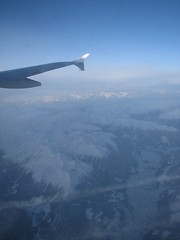




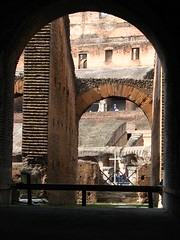


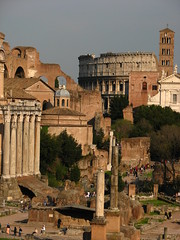

Wow, Jeremy. This erases some of my frustration I felt that you didn’t get a job for the remainder of summer. Your writing and documenting was real work…even if it didn’t enhance your checking account. And, if this type of writing comes naturally to you, well, then you owe it to the rest of the world to find more ways to share your skill. I am sooo very proud of you.
Jeremy –
As always, I really enjoy your writing. Your content and style really make it enjoyable reading as well as educational.
As far as I am concerned, you keep being “yourself” because the Jeremy we know and love is better by far than being concerned with image and partying.
Great job! I hope you find some ways to enjoy life this first semester at college! JD
Thanks Jeremy, I am enjoying reading this as I prepare for my 4 day trip to Rome. Good work, I especially loved the map, and now I am inspired to watch some Italian movies before I go too. Therese